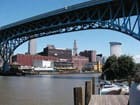The U.S. Environmental Protection Agency (EPA) and the U.S. Justice Department announced a comprehensive Clean Water Act settlement with the Northeast Ohio Regional Sewer District that will address the flow of untreated sewage into Cleveland-area waterways and Lake Erie. The settlement will safeguard water quality and protect human health by capturing and treating more than 98% of wet weather flows entering the combined sewer system, which services the city of Cleveland and 59 adjoining communities.
The Northeast Ohio Regional Sewer District discharges nearly 5 billion gal of untreated, raw sewage approximately 3,000 to 4,000 times per year into Lake Erie and nearby rivers. The settlement will require the sewer district to spend approximately $3 billion to install pollution controls, including the construction of seven tunnel systems ranging from 2 to 5 miles in length that will reduce the discharges of untreated, raw sewage to approximately 537 million gal per year. The sewer district estimates that this investment will lead to more than 30,000 jobs in the Cleveland area and return $2.63 for every $1 invested.
The settlement will also significantly advance the use of large-scale green infrastructure projects to control wet weather sewer discharges by requiring the sewer district to invest at least $42 million in green infrastructure projects. These projects will capture an additional 44 million gal of wet weather flow beyond what the tunnels and other traditional infrastructure construction improvements will capture. Green infrastructure involves the use of properties to store, infiltrate and evaporate storm water to prevent it from getting into the combined sewer system. Examples of potential green infrastructure projects include wetlands, troughs, cisterns or other formations to store water, and rain gardens, urban croplands and permeable pavement to allow for greater infiltration of water into the ground.
The settlement also will provide the sewer district with the opportunity to propose larger uses of green infrastructure in exchange for reductions in the scope of traditional infrastructure projects. The sewer district would have the potential to use legal and financial mechanisms such as the Cleveland and Cuyahoga County land banks to transform the area’s numerous vacant or abandoned properties to productive use, helping to revitalize disadvantaged communities and resulting in cleaner air and green space. The sewer district will collaborate with local community groups, including those representing minority and/or low-income neighborhoods, in selecting the locations and types of green infrastructure projects to propose. These pioneering green infrastructure portions of the settlement will further the Justice Department and EPA’s work to advance environmental justice.
In addition to installing controls and investing in green infrastructure, the sewer district will spend $1 million to operate a hazardous waste collection center. The center will provide communities in Cuyahoga County with a permanent location to drop off household hazardous waste. The collection center is expected to collect and dispose of 1 million lb of hazardous waste per year. The sewer district will also spend approximately $800,000 to improve other water resources.
The settlement also requires the district to pay a penalty of $1.2 million, which will be distributed evenly between the United States and the state of Ohio. The settlement, lodged in the U.S. District Court for the Northern District of Ohio, is subject to a 30-day public comment period and final court approval.
Source: U.S. EPA


